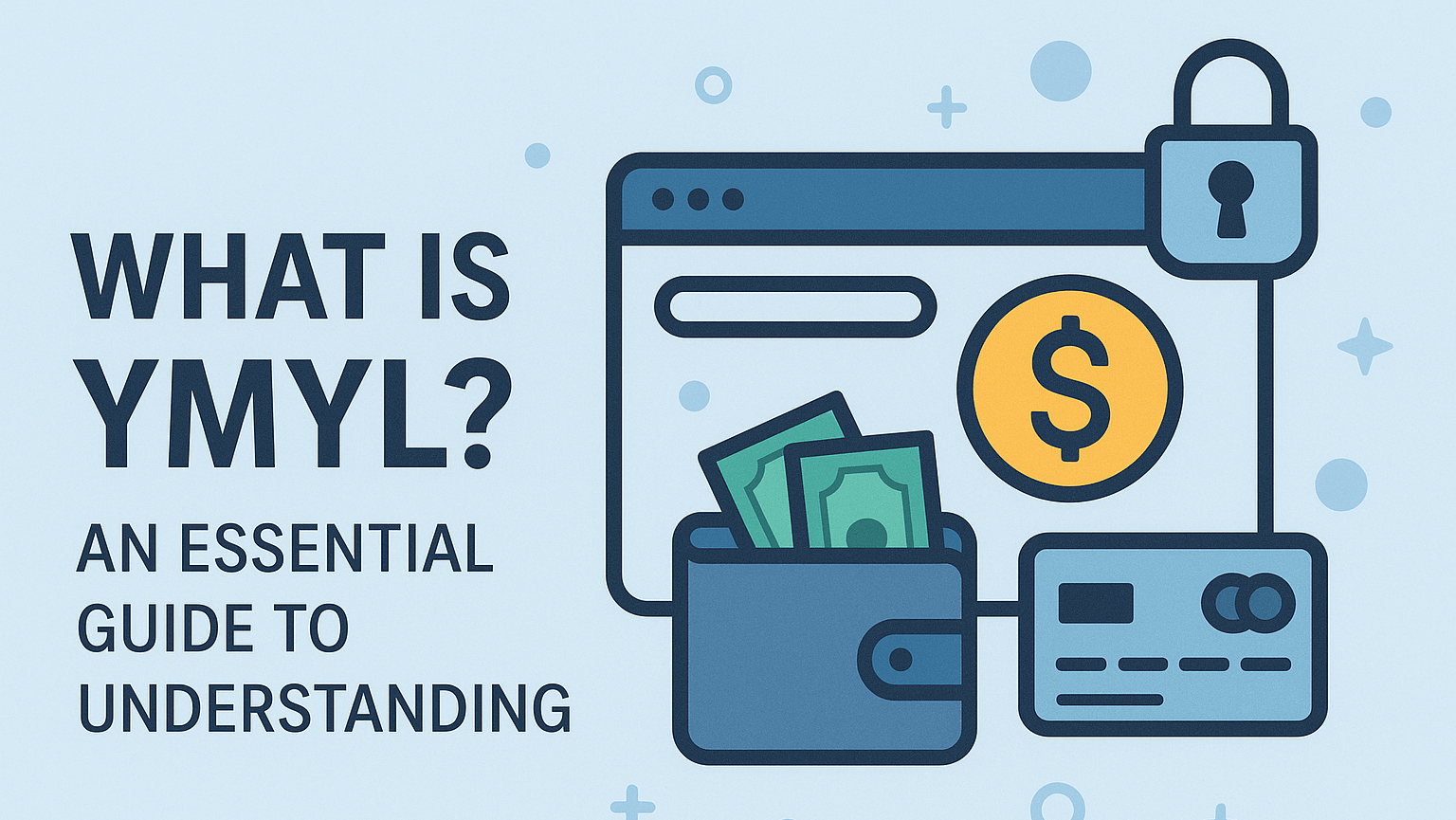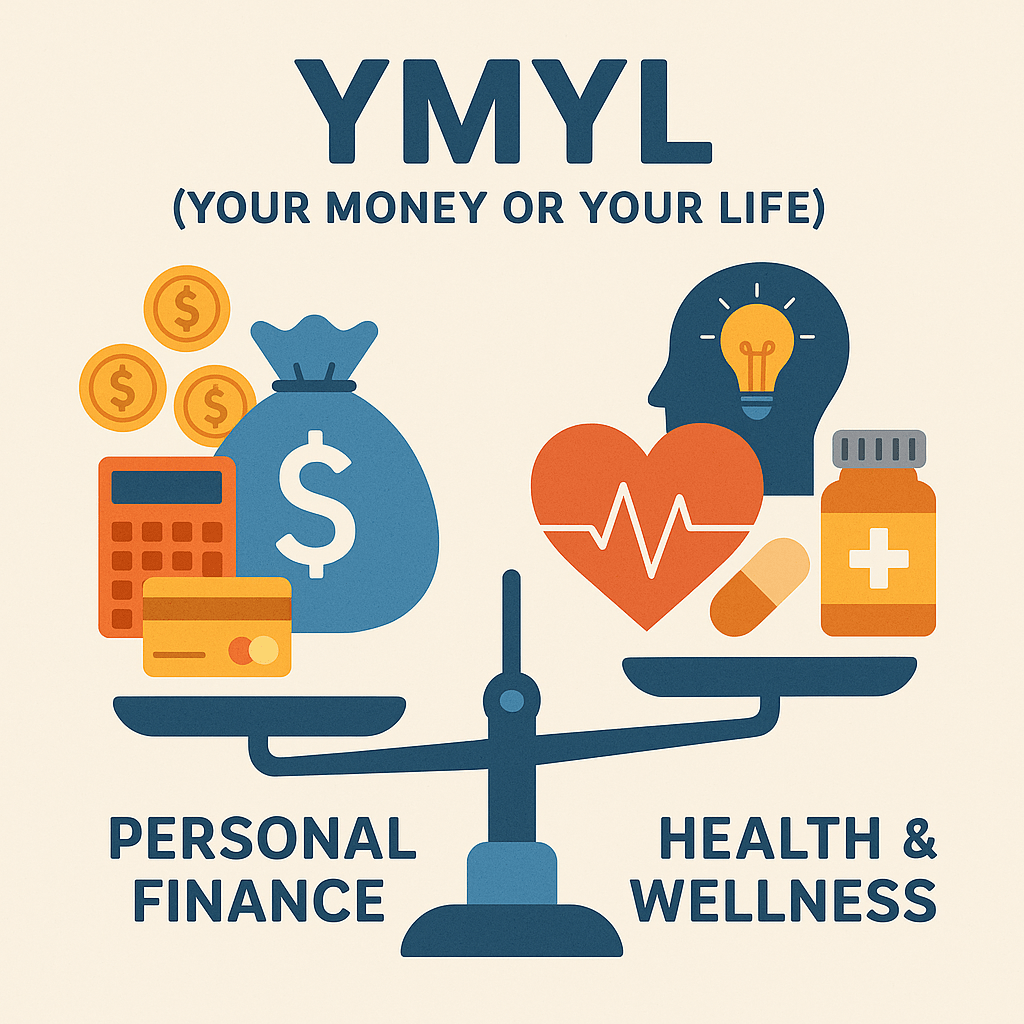
What is YMYL An Essential Guide to Understanding
What is YMYL An Essential Guide to Understanding
Most people never notice the label on their search results, yet some queries carry far higher stakes than others. A page that tells you how to treat chest pain, move KiwiSaver funds, or respond to a phishing text is not just another blog. It can change someone’s health outcome, financial stability, or legal position. That is the core idea behind YMYL, short for Your Money or Your Life.
This concept sits at the heart of how Google reviews and ranks high‑impact content. It also sets a high bar for publishers, editors, and marketers who write about topics that affect real‑world wellbeing.
What is YMYL
YMYL, which stands for ‘your money or your life’, refers to content that can affect a person’s health, finances, safety, or rights. But what is YMYL really about? Google introduced the label in its Search Quality Evaluator Guidelines and has expanded on it over the years. The guidance asks human quality raters to apply especially high standards to pages in these areas, and that approach shapes ranking systems as well.
Think of it as a risk filter. If a page carries advice that, when wrong, could seriously harm someone, then trust, accuracy, and author credibility matter more than usual.
In late 2022 Google also updated its advice to highlight first‑hand experience alongside expertise and authority. You will often see the acronym E‑E‑A‑T: Experience, Expertise, Authoritativeness, and Trustworthiness. For high‑risk topics, strong signals across all four are expected.

Where YMYL shows up in everyday searches
Plenty of online topics are casual or entertaining. YMYL is the opposite. Here are common areas that fall under this label:
- Health and medical guidance, from symptom advice to mental health resources
- Financial topics, including taxes, investing, credit, insurance, and retirement
- Legal rights and obligations, including immigration, tenancy, and consumer protections
- Public safety and emergency instructions, from natural hazards to product recalls
- News and civics, especially when it affects public policy and people’s rights
- High‑stakes purchases or services, for example medical devices, mortgages, or legal services
- Advice aimed at vulnerable groups, including children or those in crisis
The New Zealand angle matters too. Health content should reflect local standards and agencies like Manatū Hauora and Medsafe. Financial advice often involves IRD rules or the FMA’s guidance. Legal topics should match NZ legislation and practice. Local relevance boosts usefulness and trust.
Why search engines treat YMYL differently
Search quality raters are instructed to scrutinise YMYL pages with greater care. This feeds into signals that ranking systems can pick up, even though Google does not expose a single numeric score for E‑E‑A‑T. In practice, sites with strong expertise, a positive reputation, and robust sourcing from trustworthy sources fare better for high‑risk queries. Unknown sources and thin content struggle.
That higher bar exists for a simple reason. Mistakes here can hurt people.
E‑E‑A‑T, unpacked for YMYL topics
- Experience: First‑hand use or lived expertise. A clinician who has treated a condition, a licensed adviser who has handled KiwiSaver transfers, or a tenant advocate who has helped with bond disputes.
- Expertise: Formal training or proven knowledge. Degrees, certifications, registrations, and a clear record of practice in the field.
- Authoritativeness: Recognition by others. Citations from reputable sites, mentions in credible media, profiles in professional registers.
- Trustworthiness: Accuracy, sourcing, transparency, corrections, security, and responsible editorial standards. Trust is the tie that binds the other signals.
For YMYL, Trust sits on top. Everything else feeds into it.

A quick map of topics, risks, and trusted signals
| Topic type | Risk if wrong | Strong sources to cite | Proof users expect on the page |
|---|---|---|---|
| Health | Harm to body or mind | Manatū Hauora, Medsafe, clinical guidelines, journals | Doctor author or reviewer, references, last updated date |
| Finance | Monetary loss, legal penalties | IRD, FMA, Reserve Bank, peer‑reviewed or official data | Licensed adviser bio, calculators, clear disclaimers |
| Legal | Loss of rights, fines, disputes | NZ Legislation, Community Law, NZ Law Society | Lawyer review note, links to statutes, jurisdiction clarified |
| Safety | Injury, property damage | NEMA, NZ Police, Energy Safety, product manufacturer | Step‑by‑step instructions, emergency contacts, version history |
| News and civics | Public misinformation | Government releases, respected newsrooms, court records | Reporter byline, sources named, timestamped updates |
| High‑stakes buys | Debt, poor outcomes | MBIE consumer guidance, independent testing labs | Clear comparisons, full costs, refund policy explained |
The bar for creators and editors
Writing for YMYL topics calls for meticulous craft. It is not enough to sound authoritative. The work needs verifiable evidence and clear accountability.
Core habits that help:
- Attribute every key claim to a reliable source
- Keep topic scope manageable, then cover it thoroughly
- Explain trade‑offs plainly, avoid sensational language
- Bring in local context, numbers, and regulations where relevant
- Make the author’s credentials easy to find and easy to verify
- Mark the publication and revision dates, and keep pages current
A single sentence can carry heavy weight in these articles. Precision matters.
A repeatable workflow for safe YMYL content
- Define the user need and outcome. What decision will a reader make after this page?
- Map risk points. Where could wrong advice cause harm or cost?
- Compile primary sources first. Laws, official data, clinical guidelines.
- Draft in plain, unambiguous language. Avoid hype and vagueness.
- Add citations inline. Link to the exact page or section, not just the home page.
- Secure expert review. Clinician for clinical advice, lawyer for legal topics, licensed adviser for financial content.
- Run a fact check pass. Cross‑verify figures, dates, thresholds, and names.
- Add transparency features. Author bio, reviewer credit, conflicts of interest, editorial policy.
- Publish with schema and clear timestamps.
- Monitor feedback. Corrections and updates show care and improve trust.
What to show on the page itself
- Author byline and qualifications, with a link to a profile that lists credentials
- Reviewer credit where appropriate, including registration number or practising certificate
- Clear sourcing, using citations, backlinks, or footnotes readers can verify
- A visible “Last updated” date and a change log for major updates
- A simple disclaimer where the topic calls for professional advice
- Contact information or a path to get help
- Stable, secure UX: HTTPS, no intrusive ads, readable on mobile
- Relevant schema markup, for example Article, NewsArticle, MedicalEntity
All of this signals care for the reader, which is the point.
The fact‑checking playbook
- Cross‑reference primary sources. For NZ: legislation.govt.nz, health.govt.nz, medsafe.govt.nz, ird.govt.nz, fma.govt.nz, police.govt.nz, nzcivildefence.govt.nz, stats.govt.nz.
- Verify numbers twice. Interest rates, dosage ranges, date cut‑offs, thresholds.
- Quote the source directly when a precise definition or legal phrase matters.
- Prefer the latest version. Laws and guidelines change, often quietly.
- Spot weasel words and remove them. If it cannot be supported, do not say it.
- Keep a source log with URLs and access dates for audits.
One wrong digit can undo a reader’s trust.
Dealing with fast‑moving news and guidance
In fast-moving situations, such as breaking news or urgent public advice, accuracy and transparency are paramount. Research from the Reuters Institute shows that audiences are more likely to trust news sources that provide clear timestamps and document updates, helping readers distinguish between the latest information and earlier reports. It is essential to clearly separate verified facts from preliminary or unconfirmed details, and to link directly to primary sources such as official releases or government briefings. Concise, fact-based writing reduces the risk of spreading misinformation, while a visible corrections policy and a commitment to updating content as new information emerges further enhance credibility. For particularly sensitive topics, archiving previous versions ensures accountability and allows readers to track how guidance has evolved. Ultimately, while speed is important in news publishing, studies consistently show that audiences value accuracy and reliability over being first to report.
Signals beyond the article
High-quality YMYL content is most effective when it is supported by a robust and transparent website infrastructure that aligns with E-E-A-T (Experience, Expertise, Authoritativeness, Trustworthiness) principles. Research from the Nielsen Norman Group highlights that users are significantly more likely to trust sites that provide a clear About page, a physical business address, and authentic staff profiles, all of which contribute to perceived legitimacy. Readable privacy policies and terms of service further build confidence, ensuring that users understand their rights and how their data is handled. Advertising should be carefully managed so it does not overwhelm or distract from the main content, as excessive or intrusive ads have been shown to erode user trust. For sensitive topics, moderating comments or disabling them altogether helps prevent the spread of misinformation and maintains a respectful environment. Independent references, such as directory listings or mentions in reputable media, serve as external validation of a site’s credibility. Finally, maintaining a consistent editorial style that prioritises clarity and evidence-based information reinforces the site’s authority. Over time, these elements collectively establish a reputation for reliability, with every well-crafted page strengthening the foundation of trust.
Measuring quality without gaming it
There is no E‑E‑A‑T score you can watch in a dashboard, but understanding e-e-a-t principles can help you track signals that relate to trust and utility:
- Update latency: time taken to refresh pages after a regulatory or guideline change
- Correction rate and response time
- Coverage depth against a defined scope, not word count
- Share of traffic from queries where you hold recognised expertise
- Links and mentions from reputable organisations, not just volume
- Branded search growth and repeat visitors
- Engagement that indicates value, for example time on page for complex guides, scroll depth, return visits to the same guide
- Outcomes you can measure, like reduced support tickets after publishing a help article
Use these as feedback, not vanity metrics.
Common pitfalls that sink YMYL pages
- Big claims without referenced evidence
- Hype or fear in headlines and copy
- Thin affiliate content with unclear incentives
- Outdated laws or guidance left online without a warning
- Unmoderated user submissions that look like advice
- Borrowed stock bios with no way to verify qualifications
- Dead links or generic home page links instead of deep citations
- Advice that suits another country, presented as local
Each of these erodes trust fast. Fix them early.
AI’s place in YMYL writing
AI can accelerate the research and editorial process, offering valuable support in brainstorming ideas and structuring outlines. However, when it comes to YMYL content, human oversight is essential. Studies show that while AI-generated text can increase productivity by up to 40%, it is also prone to factual errors and lacks the nuanced judgment required for high-stakes topics. Every claim generated with AI must be rigorously verified against primary sources, and it is crucial to maintain a transparent record of where each fact originated. Qualified professionals should always be responsible for reviewing and approving the final copy, especially for clinical, legal, or financial advice, where expert advice is crucial, and any financial information must be carefully assessed, as regulatory bodies and search engines alike demand clear accountability. For sensitive subjects, a thorough legal and risk review is necessary to ensure compliance and accuracy. Additionally, any synthetic media or AI-generated illustrations should be clearly labelled to avoid misleading readers. Ultimately, AI should be treated as a drafting assistant that enhances efficiency, not as an authority—final responsibility for accuracy and trustworthiness must always rest with human experts.
Editorial standards that stand up in court and search
- Style guide: preferred terms, reading level, and how to present numbers and units
- Sourcing rules: what counts as a reliable source for each topic
- Review tiers: who must approve which types of content
- Conflicts policy: declare financial relationships or sponsorships
- Retention schedule: how long to keep pages, when to archive
- Incident playbook: how to issue corrections and inform readers
When standards are public, readers can hold you to them. That is a good thing.
Practical examples: what strong YMYL looks like
- A skin cancer advice page authored by a registered GP, reviewed by a dermatologist, that cites NZ melanoma statistics, shows images with captions sourced from recognised medical libraries, and invites readers to see their doctor for diagnosis.
- A KiwiSaver fees explainer that uses the latest fund data, links to the provider’s product disclosure statements, includes a calculator with transparent assumptions, and carries a plain disclaimer about personalised financial advice.
- A tenancy rights guide that quotes sections from the Residential Tenancies Act, includes links to tenancy.govt.nz, and states when the law changed, with a visible update date.
These pages reduce uncertainty and help people make sound decisions.
YMYL and SEO: Why Search Optimisation Matters for High-Stakes Content
Search engine optimisation (SEO) is not just about driving traffic—on YMYL pages, it’s about ensuring that trustworthy, accurate, and helpful information reaches those who need it most. Google’s algorithms apply stricter scrutiny to YMYL topics, making SEO best practices essential for visibility and credibility.
How YMYL Impacts Search Rankings
Google’s ranking systems are designed to protect users from harm. For YMYL queries, the search engine prioritises pages that demonstrate strong E-E-A-T (Experience, Expertise, Authoritativeness, Trustworthiness). This means that even well-written content may struggle to rank if it lacks clear sourcing, qualified authorship, or up-to-date information.
Key ranking factors for YMYL pages include:
- Author credentials and transparency: Google favours content written or reviewed by recognised experts.
- Citations and sourcing: Pages with references to primary, authoritative sources are more likely to be trusted.
- Content accuracy and freshness: Outdated or vague advice can harm rankings and user trust.
- Site reputation: A positive reputation, both on and off your site, signals reliability to search engines.
Best SEO Practices for YMYL Pages
To optimise YMYL content for search, focus on:
- Descriptive, relevant titles and headings that match the user’s intent and the page’s content.
- Structured data markup (such as Article, NewsArticle, or MedicalEntity) to help search engines understand author, reviewer, and update information.
- Internal linking to related, high-quality guidance within your site, supporting user journeys and topical authority.
- Mobile-first design and Core Web Vitals to ensure a stable, accessible experience for all users.
- Clear disclaimers and update dates to show transparency and ongoing care.
- Localisation for New Zealand audiences, including references to NZ laws, agencies, and standards.
The Bottom Line
SEO for YMYL is about more than keywords—it’s about building trust at every step. By aligning your optimisation efforts with Google’s expectations for YMYL, you not only improve rankings but also deliver genuine value to your audience.
SEO tactics that support trust
- Use descriptive titles, clear headings, and summary snippets that match the content
- Add structured data to help search engines read author, reviewer, and dates
- Provide internal links to related guidance, not just popular pages
- Optimise for Core Web Vitals to keep the experience stable on mobile
- Avoid intrusive interstitials and auto‑playing media
- Implement hreflang and local references for NZ audiences where relevant
Search engines reward pages that people find useful and reliable, particularly those that incorporate quality backlinks.
A short glossary for teams
- YMYL: High‑impact topics affecting health, money, safety, or rights
- E‑E‑A‑T: Experience, Expertise, Authoritativeness, Trustworthiness
- Primary source: Official or original publication of facts or law
- Reviewer: Qualified person who checks content for accuracy
- Update latency: Time between a change in facts and a content refresh
Clear language inside the team raises quality outside it.
Getting started: a practical checklist
- Identify YMYL topics in your content plan and rate their risk
- Assign qualified authors and reviewers, and publish their bios
- Build a source library with official NZ and international references where relevant
- Create page templates with slots for last updated date, citations, disclaimers, and reviewer credit
- Set a review cadence, for example every 3 months for finance and health pages
- Track updates to laws, clinical guidance, and regulator notices
- Train writers on plain language and bias checks
- Publish an editorial policy and a corrections policy to adhere to established guidelines.
- Monitor reader feedback and act on it quickly
- Keep every claim traceable to a reliable source
YMYL pages carry real consequences. When they are produced with care, they do more than rank. They help people make safer, smarter choices. And that is the point of publishing on these topics at all.

